
This site celebrates the life and work of sculptor John Cassidy (1860 - 1939).
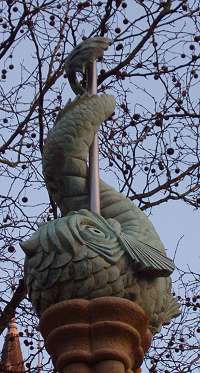
'This required the demolition of the Engraver's Arms public house, the Manchester Coffee Roasting Works, a coal yard, a smithy, a number of warehouses and workshops and a warren of back-to-back houses and courts; on what is now the open space of Albert Square were crammed about 100 buildings.'
Prince Albert, consort of Queen Victoria, died in 1861, and the site of the square was chosen, and appropriately named, as the location for the city's memorial to him, which forms its centrepiece. Designed by architect Thomas Worthington, with a figure of Albert by Matthew Noble is mounted in a 'ciborium.'
The general appearance of the structure resembles the much larger and more elaborate Albert Memorial in Kensington Gardens, London, designed by Sir George Gilbert Scott; Worthington's design had been published in The Builder magazine in 1862, some time before Scott's. In London, Albert is seated, whereas in Manchester he has to stand. 100 years later, the memorial was in poor condition, and there were suggestions that it should be removed, but it was renovated in 1977 following a public appeal.
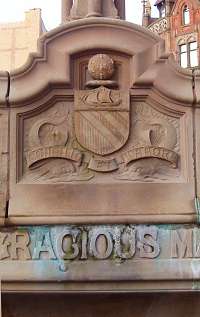
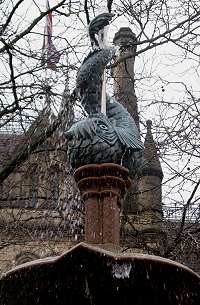
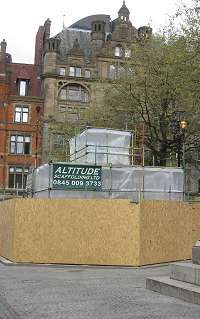
The square, and the exteriors of the buildings around, are replete with statues and other sculptures. We refer you to the works and sites listed below for more detail, but here is a list of the main portrait sculptures in the square, with links to the pages of the National Recording Project:
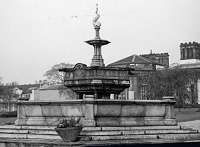
Links and references
Manchester's Irish Story
Manchester Town Hall and Albert Square, by Bob Speel.
Clare Hartwell, Manchester (Pevsner Architectural Series.) Penguin Books, 2001.
Recommended as a pocket-sized guide to the area.
John J. Parkinson-Bailey, Manchester, an architectural history. Published by Manchester University Press, 2000.
Nicola C. Smith, 'Imitation and invention in two Albert Memorials.' The Burlington Magazine, Vol. 123, No. 937 (Apr., 1981), pp. 232-237.
Clare Hartwell and Terry Wyke (Eds.) Making Manchester ... an illustrated volume of essays on the history of architecture of Manchester and the region, published in honour of John H. G. Archer on his 80th birthday. Published by the Lancashire and Cheshire Antiquarian Society, 2007.
Derek Brumhead and Terry Wyke. A walk round Manchester sculptures. Walkround Books, 1990.
Down in Albert Square...
'Twas down in Albert Square
I never shall forget,
Her eyes they shone like diamonds
And the evening it was wet, wet, wet.
Her hair hung down in curls,
She was a charming rover,
And we rode all night,
Through the pale moonlight,
Way down to Pomona.
- Manchester music hall song, recorded by "The Two Beggarmen" - sometimes claimed to be abouy Lamorna in Cornwall.
'Down in Albert
Square' *
Cassidy in the heart of Manchester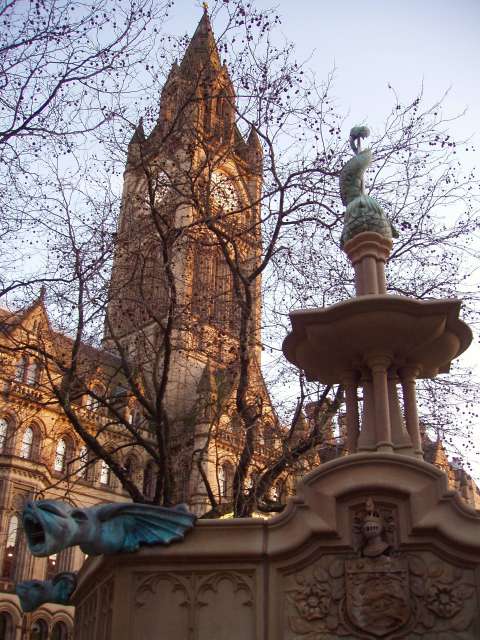
Nineteenth-Century Manchester was a proud city, wealthy from the income of its textile and engineering industries and eager to express its importance through architecture, and public sculpture had its part to play in their vision. John Cassidy set up in business at the height of this era, and although his public works in the city centre are somewhat overshadowed by those other, nationally famous, sculptors, some can be discovered by the curious. His major city centre work, 'Adrift', is sadly not on public display at the time of writing (November 2008.)
Find your way to Albert Square, a large public space, now thankfully largely traffic-free and face Alfred Waterhouse's magnificent Town Hall, and the Albert Memorial. Walk to your left and you will see the 'Diamond Jubilee Fountain' - as seen in our picture above - although it may well not actually be working.
The Jubilee referred to was 1897, the 60th anniversary of Queen Victoria ascending to the throne; there was also, at the time, celebration of the completion the same year of the Aqueduct which brings water almost 96 miles to Manchester from Thirlmere in the English Lake District. There seems to have been an 'official opening' of the aqueduct in three years earlier in 1894, for which a temporary fountain was apparently set up.
The Public Monument and Sculpture Association's National Recording Project relates:
The
question of erecting a permanent fountain in Albert Square
took a decisive turn when in the summer of 1896 the
council were informed by the Manchester architects, Thomas
Worthington and Sons, that an anonymous donor wished to
present the city with a large ornamental fountain to stand
in the square. Worthingtons were responsible for the
design, a three-basin fountain in granite and sandstone. A
bronze dolphin, modelled by John Cassidy, decorated the
top of the fountain.
Looking at it, the observer might be surprised at the description of the creature as a 'dolphin' rather than some kind of mythical sea-serpent; dolphins are mammals and do not, surely, have scaly skins.
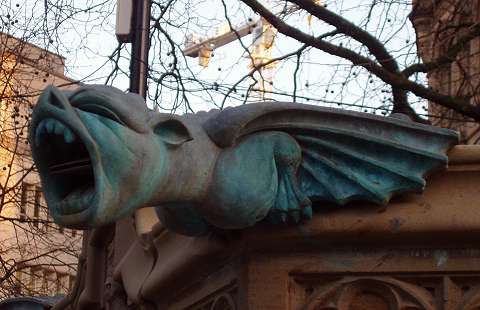
The bronze dragon-like water spouts around the basin are probably also by Cassidy, although we have no documentary evidence.
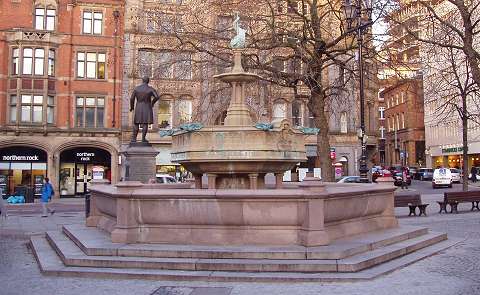
Apparently, the fountain, built in sandstone (the upper bowl is red granite) by J & H Patterson, was not always popular with the public, especially on windy days, and in 1909 it was removed to Heaton Park in north Manchester. A 1980s proposal to return into to the city centre came to nothing, but by its centenary in 1997 its time had come: Albert Square had been transformed from a large 'traffic island' to a worthwhile pedestrian space, and funding was raised to re-erect the fountain in its original location. In the words of the plaque set into the ground by the fountain:
THE
QUEEN VICTORIA JUBILEE
FOUNTAIN
COMPLETED JULY 1997
FUNDED BY
MANCHESTER CITY COUNCIL
NORTH WEST WATER
EUROPEAN REGIONAL DEVELOPMENT FUND
THIS FOUNTAIN
WAS ORIGINALLY SITED
IN THIS LOCATION
TO COMMEMORATE
THE SUPPLY OF WATER FROM
THE THIRLMERE RESERVOIR
QUEEN VICTORIA JUBILEE
FOUNTAIN
COMPLETED JULY 1997
FUNDED BY
MANCHESTER CITY COUNCIL
NORTH WEST WATER
EUROPEAN REGIONAL DEVELOPMENT FUND
THIS FOUNTAIN
WAS ORIGINALLY SITED
IN THIS LOCATION
TO COMMEMORATE
THE SUPPLY OF WATER FROM
THE THIRLMERE RESERVOIR
The cost of the re-instatement was reported as £250,000, and it was unveiled on 22 July 1997.
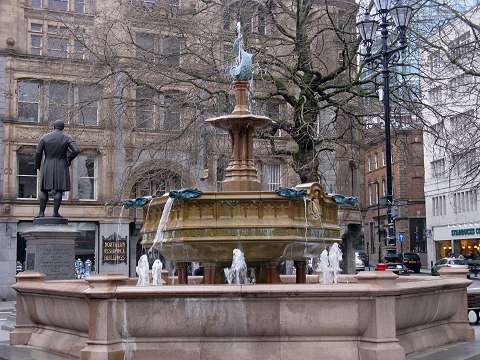
The fountain in action, April 2009.
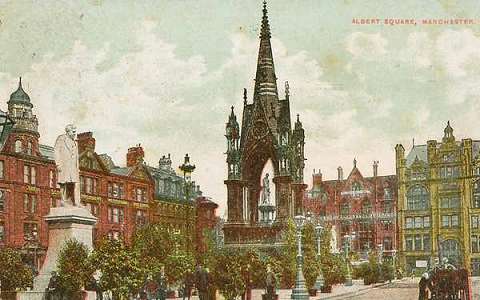
Albert Square, circa 1905.
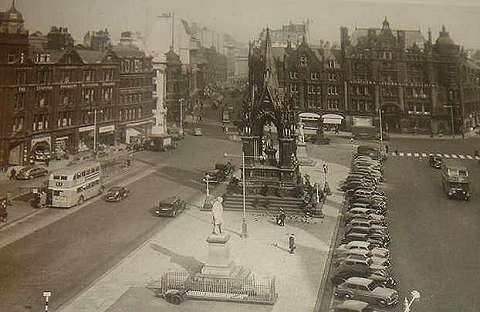
Albert Square in the 1950s: cars everywhere, and no fountain. The area to the right, in front of the town hall, is now a pedestrian space. The Albert Memorial dominates the scene: at this time it was slowly falling into dereliction, but was extensively restore in in 1978. In the foreground, the 1894 marble sculpture of Manchester worthy Oliver Heywood (1825-1892) by London-based Albert Bruce-Joy, who was one of Cassidy's chief competitors for this kind of work.
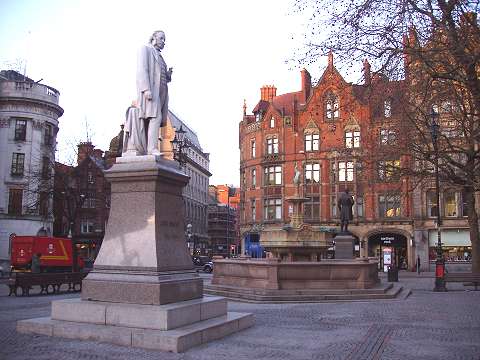
The square in 2008. In the foreground, the 1891 statue by Bruce-Joy of Manchester MP and reformer John Bright. Behind the fountain stands James Fraser, Bishop of Manchester from 1870 to 1885, sculpted by Thomas Woolner, standing with his back to the other statues in the square.
Inside the Town Hall
Note: the Town Hall closed in 2018 for a six-year refurbishment programme. Some of the works are now on display elswhere, but not, as far as we know, the Cassidy works from the Sculpture Hall.
To find more Cassidy works (and much else), if you are there during normal office hours, take a look inside the Town Hall. Enter through the main door under the tower, and climb the entrance staircase, flanked by statues of two Manchester's great scientists, John Dalton (left, by Sir Francis Chantrey, 1891) and James Joule (by Alfred Gilbert, 1893), the two considered by Brumhead and Wyke in A Walk round Manchester Statues to be 'among the most important works of art on display in Manchester.
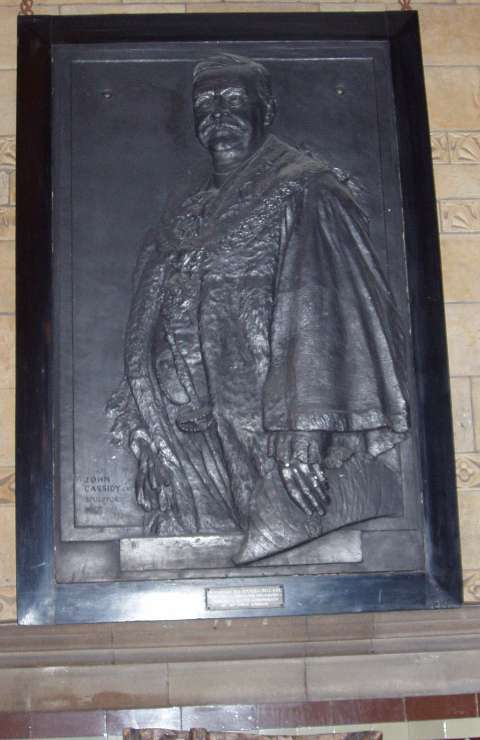
Turn right at the top of the steps and you will find the 'sculpture hall', a rather curious space which seems to have evolved from a room intended as a waiting area. It contains a collection of busts (see list on the left of this page) for which no other place could be found, but on the walls can be found two relief panels made by John Cassidy. The large bronze portrait of Alderman Sir Daniel McCabe (above) a member of Manchester City Council from 1889 to 1919, serving as Lord Mayor from 1913-15, was presented to the Corporation of Manchester by Cassidy, for reasons that become clear on study of Sir Daniel's life story.
Born in Manchester in 1852, the son of poor Irish immigrants, he rose to was elected to the City Council in from 1889. He became Manchester's first Roman Catholic Lord Mayor in November 1913, and was asked by the Corporation in 1914 to serve a second year. His sister, Mrs O'Neill, was Lady Mayoress, so we can suppose that, like Cassidy he was a bachelor, and perhaps something of a hero to him and the Manchester Irish community in general.
A Deputy Lieutenant for Lancashire from 1915, and Knighted by King George V on 15 January 1916, he was a Director of the Manchester Ship Canal. He died in London on 29 September 1919, is buried in St Joseph's Cemetery, Moston where there is another casting of the plaque.
Alcock and Brown
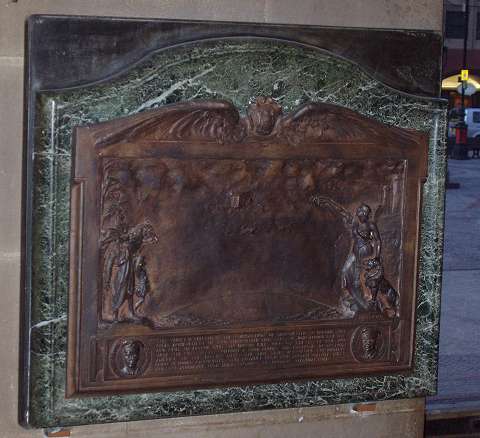
The other Cassidy panel in the sculpture hall was made to commemorate the historic first transatlantic flight, made by Manchester men Alcock and Brown. The tablet tells its own story in detail:
This tablet is erected by
the Corporation of Manchester to record the great
achievement of two Manchester men, Captain Sir John
Alcock, K.B.E., D.S.C., and Lieutenant Sit Arthur Whitten
Brown, K.B.E. who on the fifteenth day of June,
1919, were the first to fly without a stop across
the Atlantic Ocean from America to the British Isles, the
time taken in covering the distance being 15 hours 57
minutes, the distance being 1,950 English statute miles
and the aeroplane used being entirely of British
manufacture.
(Other sources differ slightly from this inscription in both time and distance.) Either side of the inscriptions are portraits of the two aviators. The tablet was unveiled by the Lord Mayor on 2 November 1921, and the next day The Times reported:
The tablet
shows the figure of an American Indian mounted on
horseback gazing across the ocean at the
disappearing aeroplane, towards which on the other side a
figure of Britannia stretches out a welcoming hand.
Two gold medals especially struck to Mr Cassidy's designs for the Corporation were presented, one to the father of the late Sir John Alcock, and the other to Sir A.W. Brown.
Two gold medals especially struck to Mr Cassidy's designs for the Corporation were presented, one to the father of the late Sir John Alcock, and the other to Sir A.W. Brown.
At least one other Alcock and Brown artifact by Cassidy is known to exist: a round medallion - perhaps a design for the gold medals - in a private collection in the USA.
The story of Alcock and Brown's famous flight in a Vickers Vimy aircraft from Newfoundland to Ireland, winning a £10,000 prize offered by the Daily Mail has been often told (Manchester Guardian report), and is commemorated in both Britain and Ireland. Both were knighted by King George V soon after their flight.
Brown, the navigator, lived on until 1948; born in Glasgow in 1886, he was brought up in Chorlton-cum-Hardy, Manchester and worked as an engineer for the Westinghouse company. The house at 6 Oswald Road, Chorlton-cum-Hardy is adorned with a 'blue plaque' in his memory
Alcock, the pilot, was born born in 1892 in Seymour Grove, Old Trafford, and later lived at 6 Kingswood Road, Fallowfield where his life is marked by a 'blue plaque.' According to Wikipedia he 'was present at the Science Museum in London on 15 December 1919 when the recovered Vimy was presented to the nation. Three days later he was flying a new Vickers amphibious plane, the Type 54 Viking, to the first postwar aeronautical exhibition in Paris when he crashed in fog at Cote d'Everard, near Rouen, Normandy stalling such that a wing hit a tree. He died before medical assistance arrived.' He is buried, like John Cassidy, in Southern Cemetery, Manchester.
Tailplane: the Manchester Airport memorial

There is another Alcock and Brown memorial in Manchester, an aluminium figure of a flying man, created by Eliazbeth Frink and installed in 1964 in the then-new Terminal at Manchester Airport. It has been controversial ever since the commission was awarded to Frink: her model of the planned work was described by Councillor Hopkins of the Airport Committee as a 'bewitched, bothered and bewildered budgerigar.' Eventually, after much dispute, it was completed and installed at a cost of £3250. Members of Alcock's family were particularly unimpressed.
The controversy was revived in 2008: According to an article in Manchester Evening News of 9 September:
'The sculpture ... drew controversy when installed in the airport's Terminal 1 in 1964, with one relative describing the winged figure as "sordid, vulgar and obscene." The statue was later moved from the terminal's arrivals hall [with the approval of the artist] to a garden next to the airport police station, and then brought into a departure lounge area. It was moved to its latest home in a connecting corridor between Terminal 1 and the airport's train station five years ago.'
Neville Alcock, the pilot's nephew, is understandably unhappy about the location. He told the reporter: 'I know we can't have these memorials up forever but if they are going to be displayed they should be kept in good condition. I went to Manchester Airport recently and managed to locate the statue after some effort. It used to have pride of place in the airport and now it is tucked away in a corner. No-one would spot it unless they made a special effort. The stonework is really dirty and no effort has been made to keep it looking clean.'
An Airport spokeswoman defended the location said it was regularly spotted by those travelling from the train station to the terminal buildings. She said: 'We consulted on where it should go and the decision was to put it in the station building. Everyone who takes the train to and from the airport can see it.'
(The Airport authorities have also removed from the terminal in 2008 the four Venetian glass chandeliers by Bruno Zaneti of Murano, which were to many people of 'a certain age' were real memories of their first visit the airport as a child.)
Mr Alcock also pointed out that exhibits at the Museum of Science and Industry - including the stuffed remains of the flying duo's mascot cat Jimmy - were no longer on display and that a memorial plaque in Manchester Town Hall had been placed in a barely-visible corner. An allegation that is hard to deny.
Written by Charlie Hulme, November 2008. Updated April 2023.